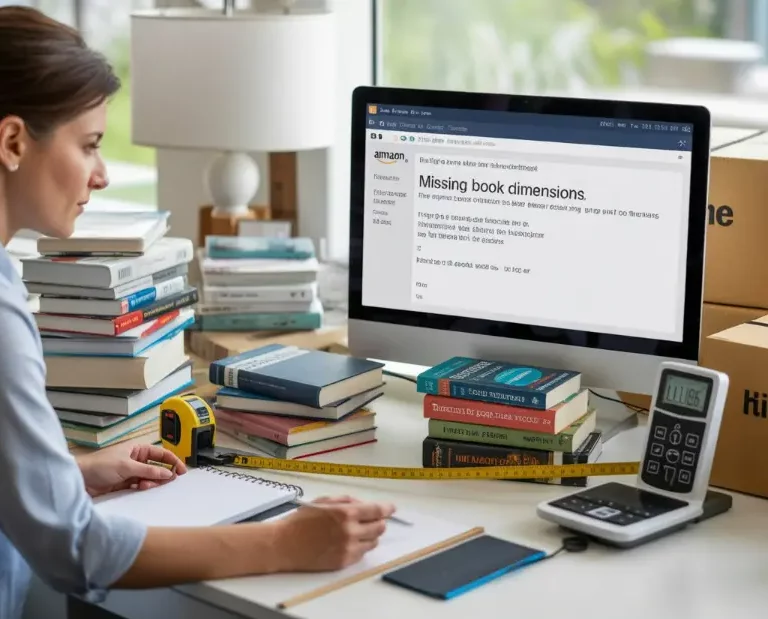How to Improve Amazon Sell-Through Rate: A Comprehensive Guide for Book Sellers

Introduction
Are you struggling to improve your Amazon Sell Through Rate (STR) and stay ahead in the competitive world of online bookselling? Don’t worry, you’re not alone. Optimizing your STR may seem daunting at first, but with the right strategies and a bit of practice, you’ll be on your way to mastering this critical metric.
In this comprehensive guide, we’ll explore the complexities of Amazon STR optimization and uncover the secrets to success. You’ll learn that improving your STR is not just about boosting sales; it’s about mastering the art of inventory management and market responsiveness. By the end of this guide, you’ll have a solid understanding of the strategies and techniques that will help lift your bookselling business to new heights on Amazon.
Understanding Sell-Through Rate: The Basics
Before we delve into the strategies, let’s clarify what Amazon Sell Through Rate is. In simple terms, STR measures how quickly your inventory sells over a given period. It’s calculated by dividing the number of units sold by the number of units available for sale, then multiplying by 100 to get a percentage.
Amazon Sell through rate = (Total Units Sold / Total Units Available for Sale) x 100
Consider this scenario: if a bookseller has successfully sold 3,000 books over the past 90 days and currently possesses an inventory of 2,200 books in Fulfillment by Amazon (FBA), the Sell-Through Rate (STR) would be calculated as follows: (3000/2200) * 100, resulting in an STR of 1.36 percent. This rate is acceptable within the book-selling industry. I will discuss further details on the ideal range for booksellers later in this blog post.
An optimal Amazon Sell Through Rate indicates that you’re stocking the right books and pricing them competitively, ensuring a steady flow of sales and inventory turnover.
Why Sell Through Rate Matters?
A robust Amazon Sell-Through Rate (STR) is vital for various reasons. It significantly influences how Amazon perceives your seller performance. It directly impacts your Inventory Performance Index (IPI) score, a key metric in determining your efficiency in managing and restocking inventory. An optimal STR is essential for maintaining a favorable status in Amazon’s eyes.
A bad Amazon Sell Through Rate can lead to increased storage fees under Amazon’s FBA services, particularly with the shift from the older “restock limits” to the more recent “capacity limits” system introduced in 2023. Under this new system, sellers with lower performance can still send additional inventory but at a higher cost compared to more successful counterparts. This is particularly critical during peak sales periods such as Christmas, semester beginnings, or Prime Day, when Amazon prioritizes efficient sellers to optimize warehouse space and operations. As the primary metric affecting capacity limits, a healthy STR is crucial to avoid additional charges and penalties during these high-demand times.
Furthermore, Amazon’s internal seller rating system, which remains largely opaque to sellers, significantly relies on STR. This rate substantially influences when and how Amazon allocates the Buy Box, with a higher STR often correlating with better visibility and sales opportunities. To remain competitive and maximize the chances of securing the Buy Box for your FBA items, closely monitoring and optimizing your STR is imperative.
In essence, understanding and maintaining a favorable Sell Through Rate is not just about avoiding penalties or extra fees. It’s about positioning yourself as a reliable and efficient seller in Amazon’s marketplace, ensuring you stay competitive and profitable in the long run.
How Do I See Sell Through Rates on Amazon?
Amazon offers a suite of tools within Seller Central that allows you to monitor your Sell-Through Rate (STR) effectively. Your Inventory Performance Index (IPI) score, a critical indicator of your FBA inventory’s health, is intrinsically linked to your FBA sell-through rate. Diligent and regular monitoring of these metrics is essential for maintaining a successful Amazon business. Here’s a detailed guide on how you can access your sell-through rate on Seller Central:
1. Navigating to Seller Central
Once logged into Seller Central, proceed to the FBA Dashboard, which is located under the ‘Inventory’ menu.
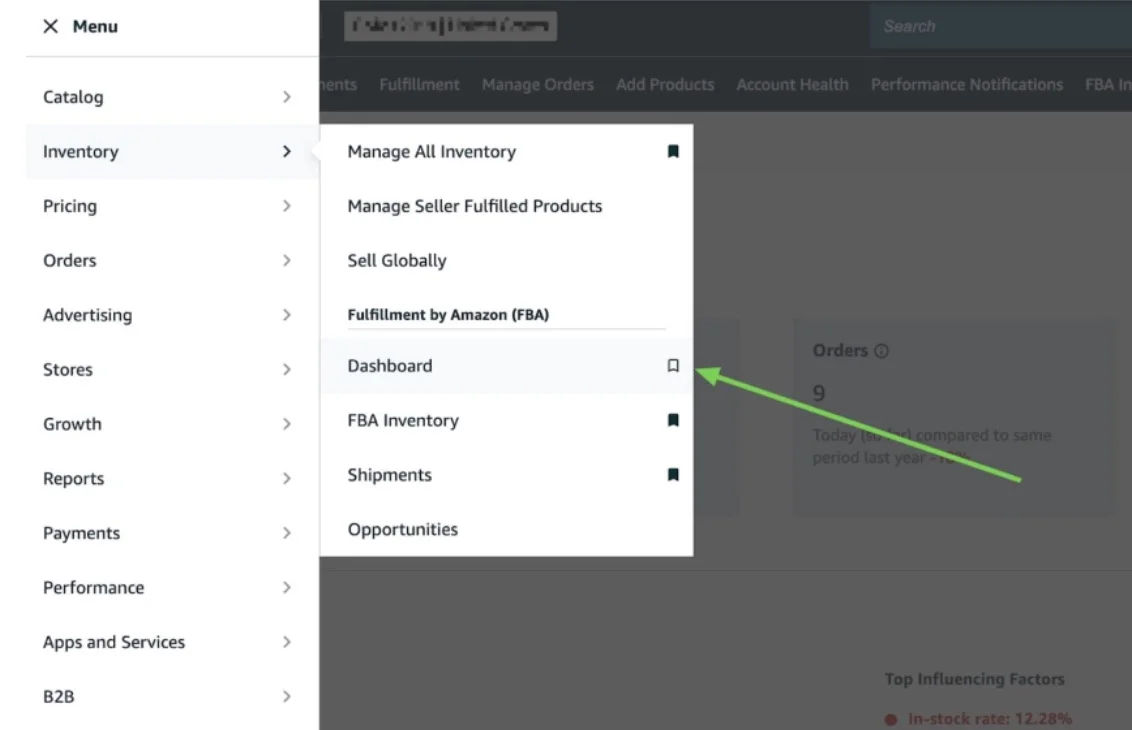
2. Understanding FBA Dashboard
On this page, your IPI score will be prominently displayed. This score provides a snapshot of your overall inventory performance, including your STR.
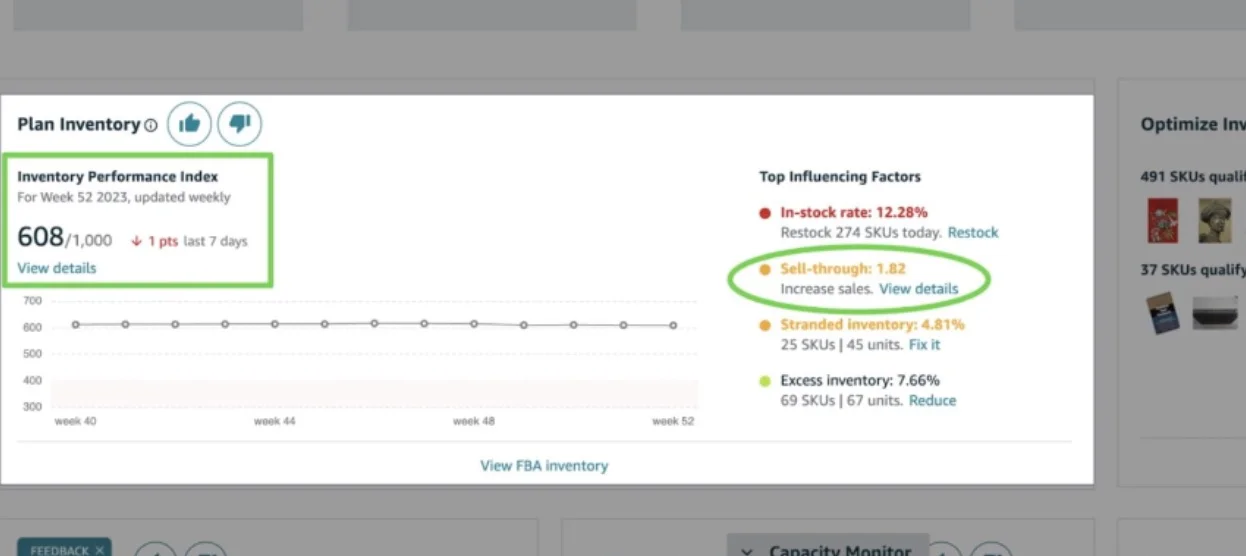
3. Exploring STR Details
Look for the “view details” option near your STR rating. Hovering over this will reveal Amazon’s evaluation of your STR. We will talk about it in detail in the following section of this blog post. There are more important details on this.
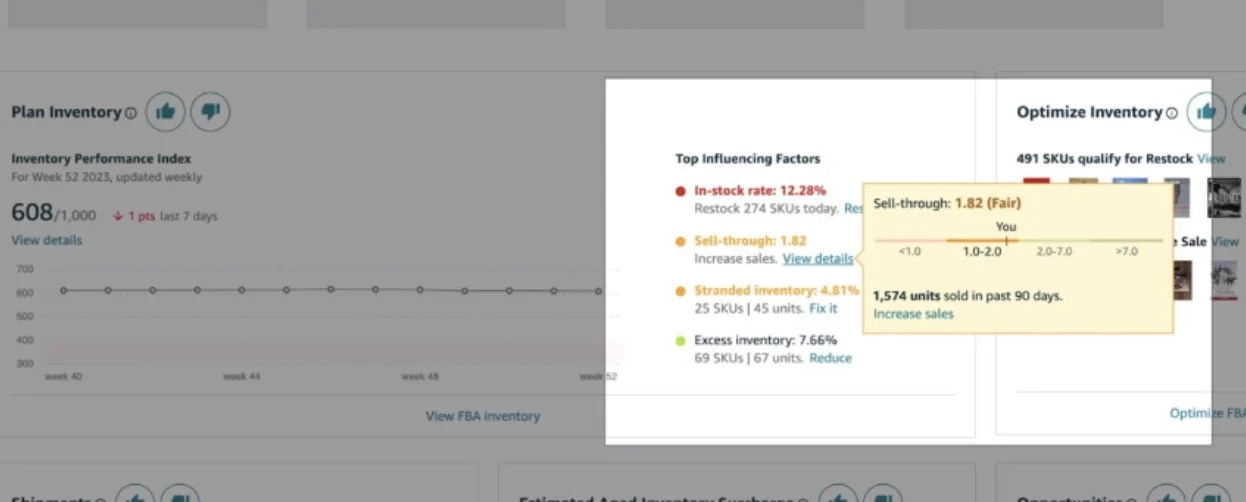
4. In-depth Analysis of Your IPI Score
Additionally, there’s a “view details” button situated near your IPI score. Clicking on this button, as illustrated below, will provide more comprehensive insights about your IPI score and the historical trends of your STR.
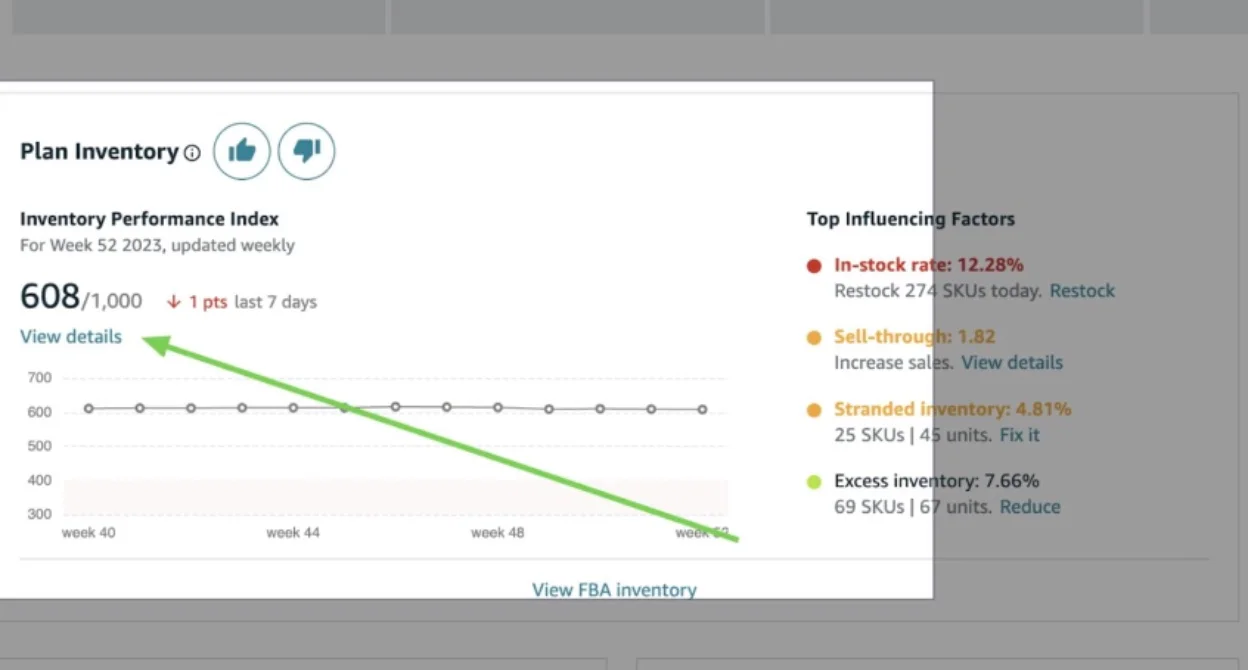
5. Historical STR Data
On the page that opens following the previous step, there’s a section dedicated to displaying your historical sell-through rate. By selecting “show more details” under your sell-through rate, you can review the history of your STR over the last 12 weeks.

Now we know where to check it but are we sure about what we want to see here? The primary focus of the next section of this blog post, is the interpretation of this data to refine your strategy on Amazon. Let’s set our goals the right way together.
What is a Good Sell-through Rate on Amazon?
Understanding what constitutes a good Sell-Through Rate (STR) on Amazon is pivotal for booksellers aiming to strike the perfect balance between sales velocity and profitability. For those specializing in selling books, especially those dealing predominantly with single-copy items and managing numerous SKUs, recognizing the nuances of a beneficial STR is crucial.
The ideal Amazon Sell sell-through rate for a typical book seller handling mostly single-copy items lies between 1.2 and 1.7. This range is considered optimal for maintaining a healthy cycle of sales while ensuring a profitable return. However, it’s important to note that the ‘goodness’ of an STR can vary significantly based on the nature of your business. Wholesalers or bulk purchasers, for instance, might have different benchmarks due to the distinct nature of their inventory and sales strategies.
An STR below 1.0 is universally acknowledged as a red flag, indicating sluggish sales and the potential for accruing excess inventory costs. Such a low rate can signal inefficiencies in inventory management or a misalignment with market demand, both of which can erode profitability and harm your standing with Amazon.
Conversely, an STR above 1.7, while seemingly positive, might suggest that you’re not capitalizing on all available opportunities. Particularly for those who meticulously select their inventory (often referred to as ‘cherry pickers’), an STR significantly higher than 1.7 might imply that you’re leaving money on the table by not stocking enough of the right products to meet demand.
Illustration of Amazon Sell-Through Rate with Bookzy Mobile
To illustrate, consider a seller focusing on books that typically sell more than 20 days or more in the last 6-month time period, as indicated by “Sold Days” data in the Bookzy Mobile App. Such a seller aligns with Amazon’s preferred profile, maintaining an inventory that moves at a steady, predictable pace. However, focusing solely on being the ideal Amazon seller isn’t the sole objective. Profitability must not be overshadowed.
If a seller chooses to stock books with “Sold Days” between 10 and 20, they might observe a slight dip in their STR. Yet, this strategy could yield higher profits due to the higher turnover of moderately demanded books. Ignoring your STR isn’t an option, either. A poor sell-through rate can tarnish your reputation in Amazon’s eyes, adversely affecting crucial factors like the buy box algorithm.
This is where understanding the balance and interplay between FBA and FBM operations becomes essential. For instance, a book that doesn’t sell as frequently but promises high profitability might be better listed as FBM to maintain a healthy overall STR while capturing profitable sales. You can read this blog post to understand the topic of FBA vs. FBM better.
In essence, a nuanced understanding of your STR is not just about adhering to Amazon’s metrics; it’s about smartly managing your inventory to ensure you’re not just selling well but selling smart. By closely monitoring and adjusting your approach to your STR, you can maintain a profitable, competitive stance on Amazon, ensuring you’re recognized as a quality seller while maximizing your return on investment.
Factors Affecting Sell-Through Rate
Several pivotal factors can significantly influence your Amazon Sell Through Rate (STR) in the dynamic world of online bookselling on Amazon. Understanding and mastering these elements is crucial as they directly impact your profitability. An effective STR strategy is not a one-size-fits-all; it requires a nuanced approach tailored to your business model. Let’s explore these factors in detail for a bookseller who has many single-copy SKUs:
Inventory Selection
A well-curated inventory is the backbone of a successful bookselling business on Amazon. The key lies in strategically allocating books to FBA and FBM channels. Employ tools such as the Bookzy Mobile App to assess “Sold Days” data, thereby ensuring a swift turnover for books directed to FBA while allocating high-profit books with a slower sales pace to FBM. This approach is instrumental in maintaining a robust FBA sell-through rate while optimizing profitability. For a more comprehensive understanding and to begin optimizing your inventory purchasing today, visit the Bookzy Mobile App page.
Pricing Strategy
Competitive and smart pricing is instrumental in attracting buyers and ensuring a swift inventory turnover. Your books’ prices should strike a balance between being attractive to customers and profitable for your business. Employ dynamic pricing strategies using tools like Bookz Pro’s Repricer, which adjusts your prices based on market conditions and competition. Keep an eye on competitor pricing to stay at the front line. However, avoid underpricing your books significantly, as it could erode your profit margins. A strategic pricing approach will not only improve your STR but also enhance your overall market competitiveness.
Promotional Efforts
Visibility is key in the vast marketplace of Amazon. Employing effective promotional strategies can significantly increase your sales and improve your sell through rate. THIS IS NOT A VALID METHOD FOR BOOKSELLERS. However, if you are selling replenishable items that you can regularly supply, you could check out some useful applications from Helium10.
Regular Monitoring and Adaptation
In the dynamic Amazon marketplace, adapting and responding to changes is essential. Regular monitoring of your inventory is crucial for maintaining a competitive edge. Utilize tools like Amazon Seller Central and Bookz Pro’s Stock Manager to monitor your inventory performance. It’s important to identify both slow and fast-moving books, adjusting your strategies to suit market demands.
Market conditions can cause fluctuations in book prices. Setting a minimum price can safeguard your margins when prices drop until the market recovers. Conversely, during times of reduced competition when prices might spike, a maximum price cap ensures your books remain attractive to buyers. Defining these price thresholds is complex, especially for sellers with extensive inventories.
This is where the synergy of Bookz Pro’s repricing and stock management services becomes invaluable. They complement each other, providing a comprehensive solution for pricing and inventory management. The Stock Manager is designed to work alongside the repricer, offering an additional layer of control and insight. It’s not about choosing one over the other but leveraging both to maximize efficiency and profitability.
For sellers looking to streamline their operations and optimize their Sell-Through Rate (STR), Bookz Pro offers an integrated approach. Visit our web page to discover more about how our services can enhance your Amazon bookselling business.
Take Your Amazon Selling to the Next Level with Bookz Pro
All in One Software
for Book Sellers
Scout Better – List Faster – Reprice Smarter
Over 30% Business Growth
Achieved by Our Clients
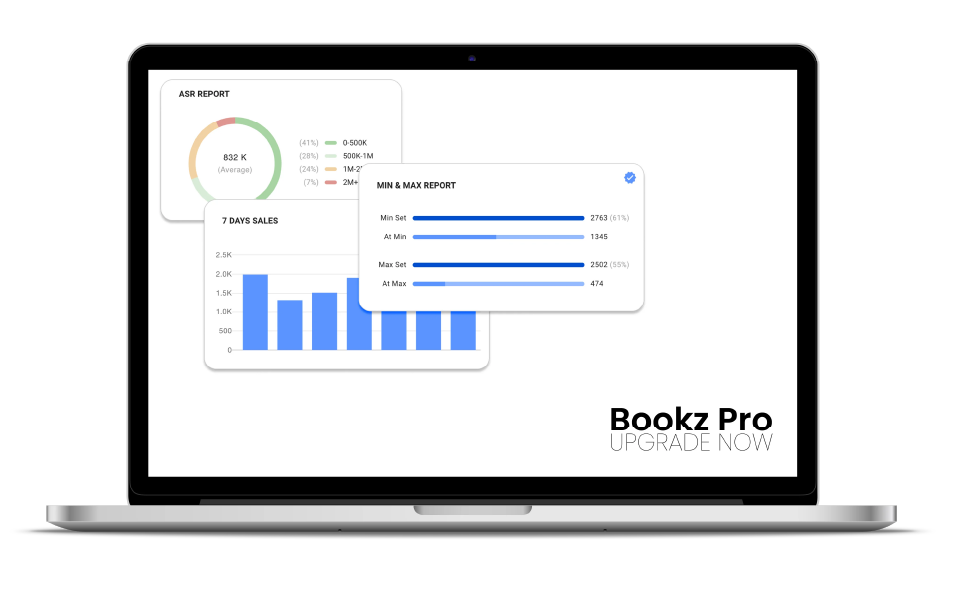
Bookz Pro is the ultimate toolkit for Amazon sellers. Combining a powerful lister, intelligent repricer, and advanced inventory management, our platform empowers you to optimize your business.
Stop wasting time on manual tasks. Bookz Pro’s features and AI-driven analytics handle the heavy lifting, helping you:
- Optimize pricing for maximum profitability
- Streamline operations and boost efficiency
- Grow your sales effortlessly
Whether you’re a business geek or just starting out, Bookz Pro’s standard package has everything you need to succeed on Amazon. Explore Bookz Pro and take the first step towards Amazon selling mastery.
Conclusion
Enhancing your Amazon Sell Through Rate is a continuous journey of monitoring, analysis, and strategic adjustments. By understanding what STR is, why it matters, and how to improve it, you’re well-equipped to optimize your bookselling business. Remember, a healthy STR not only boosts your sales but also enhances your standing with Amazon, paving the way for sustained success in the competitive world of online bookselling.

Frequently Asked Questions
STR measures how quickly a product sells relative to available inventory. It’s calculated by dividing units sold by the average units available over a period.
Sell Through Rate (STR) is crucial for Amazon booksellers because it significantly impacts their Inventory Performance Index (IPI) score and influences Amazon’s perception of seller performance. A good STR helps avoid increased storage fees, secures better Buy Box opportunities, and positions the seller as reliable and efficient in Amazon’s marketplace.
To improve their Amazon Sell Through Rate, booksellers should focus on strategic inventory selection and implement smart, competitive pricing strategies. Regular monitoring of inventory performance and quick adaptation to market conditions are also crucial for optimizing STR.
A 1.2% or higher STR is generally considered healthy, but it varies by category and competition.
Monitor STR weekly to identify trends and make timely adjustments to pricing, inventory, and marketing strategies. Closely tracking STR helps identify underperforming products and improve overall Amazon sales.



